| Twisted Winged Parasites |
| Written by Jonathan C. Wojcik - Photo credits unknown or from public news articles unless otherwise noted. If you know their sources and need them credited or removed, please e-mail me. |
Imagine, for a moment, growing up with an adopted sister that does nothing but tell you what
to do, live off your hard work and invite strange men over without your consent. Now imagine
that she lives buried up to her neck in your flesh. Now imagine that she's gotten herself
pregnant.
This nightmare worthy of a Cronenberg film is experienced every day by billions of insects
around the world. The Strepsipterans are an ancient order of insects who exhibit some of the
weirdest, most advanced parasitism in the animal kingdom, with around 600 species
invading the bodies of bees, ants, flies, roaches, silverfish, beetles, true bugs, leafhoppers
and even the mighty mantids.
The name "Strepsiptera" means "twisted-wing," and as you may have surmised, wings are
hardly the most twisted thing about these little monsters. We're going to take a detailed look
at every stage in the Strepsipteran life cycle, and each one is going to be weirder than the last.
to do, live off your hard work and invite strange men over without your consent. Now imagine
that she lives buried up to her neck in your flesh. Now imagine that she's gotten herself
pregnant.
This nightmare worthy of a Cronenberg film is experienced every day by billions of insects
around the world. The Strepsipterans are an ancient order of insects who exhibit some of the
weirdest, most advanced parasitism in the animal kingdom, with around 600 species
invading the bodies of bees, ants, flies, roaches, silverfish, beetles, true bugs, leafhoppers
and even the mighty mantids.
The name "Strepsiptera" means "twisted-wing," and as you may have surmised, wings are
hardly the most twisted thing about these little monsters. We're going to take a detailed look
at every stage in the Strepsipteran life cycle, and each one is going to be weirder than the last.
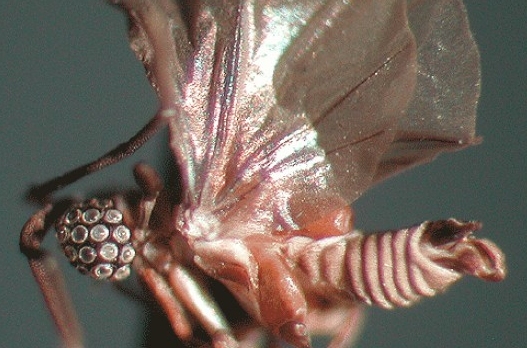
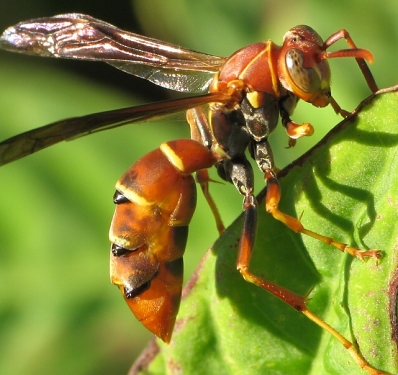
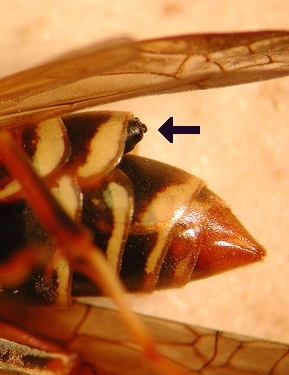
| Left photo by smccann |
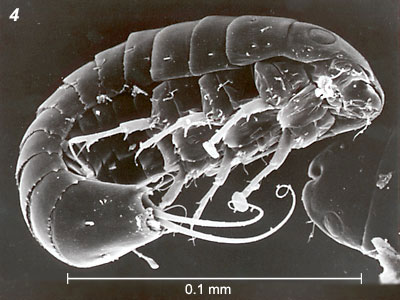
A larval Strepsipteran is known as a Triungulin, and begins its life with simplistic eyes, a full
set of appendages, spiny armor plating and a muscular tail that allows it to leap. This flea-like
form typically lies in ambush for its preferred insect host, with many species hitching rides
until they can attack the host's larvae or eggs. Secreting a corrosive enzyme from its mouth, it
melts its way into the appropriate host body and molts into a blind, limbless parasitic form,
absorbing nutrients and inducing the host's tissues to form a protective bag around its body,
effectively cloaking it from the host immune system. Depending on its sex, the parasite will
eventually metamorphose into one of two drastically different forms...
set of appendages, spiny armor plating and a muscular tail that allows it to leap. This flea-like
form typically lies in ambush for its preferred insect host, with many species hitching rides
until they can attack the host's larvae or eggs. Secreting a corrosive enzyme from its mouth, it
melts its way into the appropriate host body and molts into a blind, limbless parasitic form,
absorbing nutrients and inducing the host's tissues to form a protective bag around its body,
effectively cloaking it from the host immune system. Depending on its sex, the parasite will
eventually metamorphose into one of two drastically different forms...
It is the adult male for which these parasites are named, bearing fan-like wings highly unlike
the wing structures of most other insects. Of greater interest to science, however, are the
male's powerful and peculiar eyes; while other insects use thousands of weak lenses to form
a single compound eye, each bubble-like lens on this guy's head is a complete, highly
sophisticated eye all its own. This structure is remarkably similar to the eyes of extinct
trilobites, but otherwise seen nowhere else in the natural world.
the wing structures of most other insects. Of greater interest to science, however, are the
male's powerful and peculiar eyes; while other insects use thousands of weak lenses to form
a single compound eye, each bubble-like lens on this guy's head is a complete, highly
sophisticated eye all its own. This structure is remarkably similar to the eyes of extinct
trilobites, but otherwise seen nowhere else in the natural world.
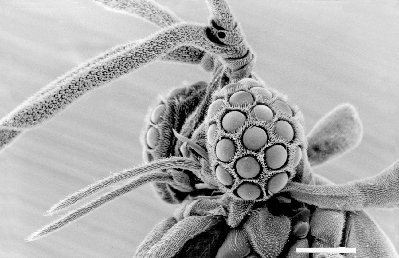
Living for only a few hours, the male has little time to mate and no time to feed; his
mouthparts only function as additional sensory equipment, helping him follow the pheromone
trails released only by virgin females of his own species...
mouthparts only function as additional sensory equipment, helping him follow the pheromone
trails released only by virgin females of his own species...
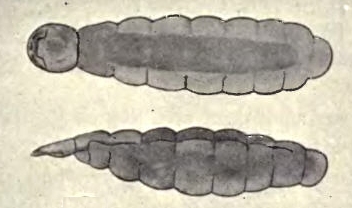
Here is where the Strepsiptera truly shine as parasites, as the female larvae only
metamorphose into more worm-like adults and will spend the rest of their days embedded or
"stylopised" in their host, exposing only their pointed, eyeless faces. In some species, the
female may force the host to aid her in the mating process, climbing high and staying put for
the winged males to find. Lacking a conventional reproductive orifice - and facing the wrong
way in the first place - the female must be penetrated by the male's incredibly long, sharp
penis (see also bedbugs) through a special breaking point on the back of her neck, the
same channel through which she will eventually give birth.
metamorphose into more worm-like adults and will spend the rest of their days embedded or
"stylopised" in their host, exposing only their pointed, eyeless faces. In some species, the
female may force the host to aid her in the mating process, climbing high and staying put for
the winged males to find. Lacking a conventional reproductive orifice - and facing the wrong
way in the first place - the female must be penetrated by the male's incredibly long, sharp
penis (see also bedbugs) through a special breaking point on the back of her neck, the
same channel through which she will eventually give birth.
Fertilized eggs will hatch still inside their mother's body, and the tiny larvae will swim and feed
within her blood, another quality unheard of in any other animal. She will deposit them on
whatever vegetation her host species frequents, and often employs more mind-control to this
end, forcing the host to drag its body along flowers while the larvae are being up-chucked. In
species that attack social bees or wasps, they may even induce slothfulness in the host;
rather than work hard with its sisters, the wasp will conserve enough energy to survive the
winter, allowing the parasite to release its young in spring.
As simple mammals, we can scarcely imagine what it must be like to have a little man fly by
and impregnate the face sticking out of your back, nor is it easy to fathom living out your
lifespan cocooned in the meat of a titanic wasp or cockroach...but I hope at least some of you
will carry these lovely visions into your dreams tonight. That's what this website is all about.
within her blood, another quality unheard of in any other animal. She will deposit them on
whatever vegetation her host species frequents, and often employs more mind-control to this
end, forcing the host to drag its body along flowers while the larvae are being up-chucked. In
species that attack social bees or wasps, they may even induce slothfulness in the host;
rather than work hard with its sisters, the wasp will conserve enough energy to survive the
winter, allowing the parasite to release its young in spring.
As simple mammals, we can scarcely imagine what it must be like to have a little man fly by
and impregnate the face sticking out of your back, nor is it easy to fathom living out your
lifespan cocooned in the meat of a titanic wasp or cockroach...but I hope at least some of you
will carry these lovely visions into your dreams tonight. That's what this website is all about.